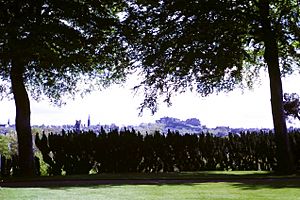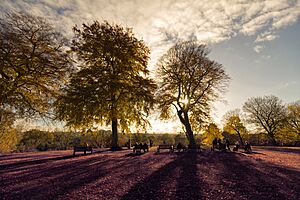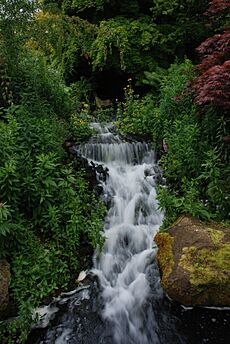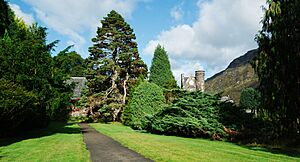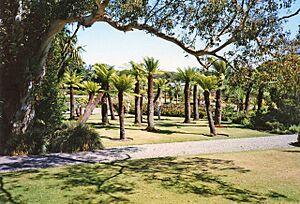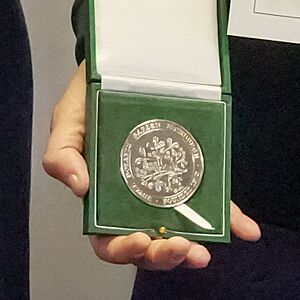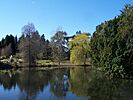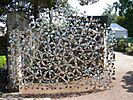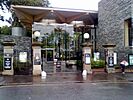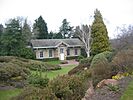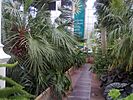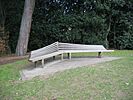Royal Botanic Garden Edinburgh facts for kids
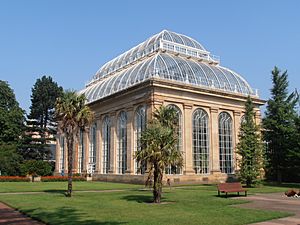 The Palm House in the Royal Botanic Garden |
|
| Non Departmental Public Body overview | |
|---|---|
| Formed | 1670 (in Holyrood Park) 1820 (moved to current Inverleith site) |
| Preceding agencies |
|
| Type | Executive Non Departmental Public Body Registered charity (number SC007983) |
| Jurisdiction | Scottish Government |
| Headquarters | 20A Inverleith Row Edinburgh EH3 5LR 55°57′54″N 3°12′36″W / 55.96500°N 3.21000°W |
| Employees | 250 |
| Annual budget | £12.3 million (2010–11) |
| Minister responsible |
|
| Non Departmental Public Body executive |
|
| Parent department | Economy Directorates |
| Child agencies |
|
The Royal Botanic Garden Edinburgh (RBGE) (Scottish Gaelic: Gàrradh Luibh-eòlais Rìoghail Dhùn Èideann) is a super important place for studying plants. It helps us understand their amazing variety and how to protect them. It's also a very popular place for visitors!
The garden started in 1670 as a "physic garden" to grow plants used for medicine. Today, it has four locations across Scotland. These are in Edinburgh, Dawyck, Logan, and Benmore. Each location has its own special plant collection.
The RBGE has over 13,302 different plant species growing in its living collection. Its herbarium (a collection of dried plant specimens) holds more than 3 million preserved plants. The Royal Botanic Garden Edinburgh is a public body of the Scottish Government. The Edinburgh site is the main garden and its headquarters. It is led by the Regius Keeper, Simon Milne.
Contents
History of the Garden
The Edinburgh botanic garden began in 1670. It was founded by Robert Sibbald and Andrew Balfour near Holyrood Palace. It is the second oldest botanic garden in the UK, after the one in Oxford.
The first plants came from the private collection of Sir Patrick Murray. This first garden was quite small. In 1676, a second, larger garden was leased. This new site was near the Nor Loch, which is now where Waverley Station is.
In 1689, the Nor Loch was drained for military reasons. This caused the garden to flood with mud, damaging many plants. So, in 1695, the garden moved back to the Holyrood area. An old map from 1804 shows this as the "Old Physick Garden." Today, a plaque at platform 11 of Waverley railway station marks its spot.
In 1763, the garden moved again to a bigger site. This new "Physick Garden" was five acres and located on the west side of Leith Walk. Professor John Hope was in charge at this time. This area is now known as Bellevue and Hopetoun Crescent Gardens.
Professor Hope was the first to successfully grow Turkish rhubarb in Great Britain. Rhubarb was very expensive to import and used as medicine. So, growing it here was a big deal!
A small cottage from the garden's original site stayed on Leith Walk for over 100 years. In 2008, it was carefully moved brick by brick to the current gardens. The move was finished in 2016. The garden was a popular place for plant scientists. It even supplied plants to other famous gardens like Kew.
In the early 1820s, the garden moved to its current location. This was under the guidance of William McNab, the Curator. The amazing Temperate Palm House was built in 1858. It is still the tallest in Scotland.
In 1877, Inverleith House was added to the gardens. The remodeled grounds opened to the public in 1881. The botanic garden at Benmore became the first "Regional Garden" of the RBGE in 1929. Later, the gardens at Logan and Dawyck joined in 1969 and 1978.
The Garden at Edinburgh
The main RBGE site in Edinburgh is very important globally. It helps protect biodiversity, which means the variety of all life on Earth. The garden is about one mile from the city centre and covers 70 acres.
The RBGE works on many projects to protect plants, both in their natural homes and in special collections. Their main scientific work focuses on Scottish Biodiversity, Plants & Climate Change, and Conservation.
Besides its science work, the garden is a popular spot for visitors. Locals call it "The Botanics." It's a great place for a walk, especially for families. Entry to the garden is free, but there's a small fee for the glasshouses. The garden also hosts many events, like live shows and exhibitions. It's also a key place for education, offering courses at different levels.
In 2009, the John Hope Gateway building was opened. John Hope was the first Regius Keeper of RBGE.
Living Plant Collection
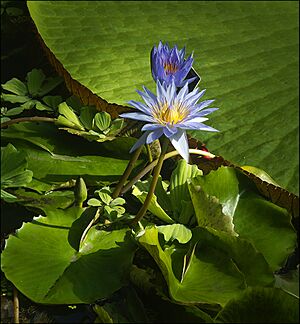
The RBGE grows almost 273,000 individual plants. These are found in Edinburgh or its three smaller gardens across Scotland. These plants represent about 13,300 species from all over the world. This is about 4% of all known plant species!
You can find a list of the RBGE's living collection online here. It is updated every night.
Some special collections at the Edinburgh garden include:
- Alpine Plants (plants from high mountains)
- Chinese Hillside
- Cryptogamic Garden (plants like mosses and ferns)
- The Glasshouses, which include:
- Palmhouse (with Temperate and Tropical Palms)
- Orchids and Cycads
- Ferns and Fossils
- Plants and People (with the Giant Water Lily pond)
- Temperate Lands
- Rainforest Riches
- Arid Lands (dry areas)
- Montane Tropical House (with Carnivorous plants)
- Wet Tropical House
- Peat Walls
- The Queen Mother's Memorial Garden
- Rock Garden
- Scottish Heath Garden
- Woodland Garden
Herbarium: A Plant Library
The RBGE herbarium is a world-leading collection of dried plant specimens. It is located in a special building at the Edinburgh site. It holds over 3 million specimens! Before this herbarium, plant collections were usually owned by the Regius Keeper.
The herbarium as we know it today started in 1839–40. This was when the collections from the University of Edinburgh and the Botanical Society of Edinburgh joined together. The RBGE's Herbarium moved into its current building in 1964.
Over the years, many collections have been added. These include plants from famous botanists and other universities. About a third of the herbarium can be searched in a database. The code for the RBGE herbarium is E. This code is used when people write about specimens from here.
Library: Books About Plants
The RBGE's Library is Scotland's main collection for special books about plants and gardening. It has about 70,000 books and 150,000 magazines and journals. This makes it one of the country's largest libraries of its kind.
The library helps staff and students with their research and studies. Visiting researchers also use it a lot. As a national collection, the Library is also open to the public. You can visit in person, call, or email them.
Inverleith House: Art and History
Inverleith House is an old building from the 1700s. It is located right in the middle of the modern botanic gardens. From 1960 to 1984, it was the first home of the Scottish National Gallery of Modern Art. Artworks were shown inside the house and in the gardens.
Since then, Inverleith House has been an art gallery for modern art. It shows different exhibitions by invited artists. Its spring shows often feature items from the Botanics' historical collections. It also displays works by modern artists. The Royal Botanic Garden Edinburgh manages the gallery.
Regional Specialist Gardens
The RBGE has three other special gardens in different parts of Scotland. Each one is unique because of its climate and what it grows.
Benmore Botanic Garden
Benmore Botanic Garden is on the West Coast of Scotland. It has a wetter and milder climate than Edinburgh. This garden grows trees and shrubs from places with lots of rain. It's famous for its conifers (like pine trees) and rhododendrons. A highlight is an avenue of giant Sequoiadendron trees. It also has a newly fixed Fernery with rare ferns.
Dawyck Botanic Garden
Dawyck Botanic Garden is south of Peebles in the Scottish Borders. It's perfect for strong plants from cooler, drier parts of the world. Dawyck is also known for its many types of fungi and cryptogams (plants like mosses and lichens).
Logan Botanic Garden
Logan is Scotland's most exotic garden. It has an almost sub-tropical climate, which is very warm and humid. This climate is great for plants from the Southern Hemisphere.
Royal Botanic Garden Edinburgh Medal
The Royal Botanic Garden Edinburgh Medal started in 2010. It is given out sometimes to honor someone who has made a great contribution. This could be a staff member or anyone else who helps the RBGE's work. The medal is made of silver. One side has a sibbaldia flower, and the other has a picture of Robert Sibbald.
Gallery
-
The avenue of Giant Redwoods at Benmore
See also
 In Spanish: Real jardín botánico de Edimburgo para niños
In Spanish: Real jardín botánico de Edimburgo para niños
- Royal Caledonian Horticultural Society
- DoCoMoMo Key Scottish Monuments
- Gardens in Scotland
- List of botanical gardens in the United Kingdom
- List of Category A listed buildings in Edinburgh
- List of post-war Category A listed buildings in Scotland
- Prospect 100 best modern Scottish buildings


